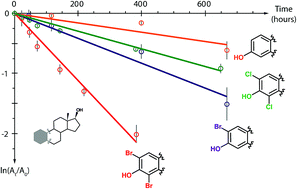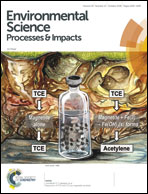Photochemical degradation of halogenated estrogens under natural solar irradiance†
Abstract
Halogenated estrogens are thought to be moderately potent endocrine-disrupting compounds that are formed during chlorine-based wastewater disinfection processes and may represent a significant fraction of the total amount of estrogen delivered from wastewater treatment plants to receiving waters. Yet we lack key information about the photochemical degradation of halogenated estrogens, a process that has important implications for UV-based wastewater treatment and environmental fate modeling. To better understand halogenated estrogen degradation in aquatic environments, we studied the direct photolysis of 17β-estradiol (E2), 2-bromo-17β-estradiol (monoBrE2), 2,4-dibromo-17β-estradiol (diBrE2), and 2,4-dichloro-17β-estradiol (diClE2) as well as the indirect photolysis of diBrE2 under natural solar irradiance. We found that direct photolysis rate constants increased with halogenation as pKa values decreased and molar absorptivity spectra shifted toward higher wavelengths. Compared to E2, quantum yields were threefold larger for monoBrE2, but 15–32% smaller for the dihalogenated forms. The rate of diBrE2 (pKa ∼ 7.5) photolysis was strongly influenced by pH. At pH 7, diBrE2 degraded on minute time scales due to the large red-shifted molar absorptivity values and greater quantum yields of the phenolate form. Degradation rates were only slightly different in the presence of Suwannee River Humic Acid (5 mg L−1), and quenching experiments pointed to excited triplet state dissolved organic matter (3DOM*) as the dominant reactive intermediate responsible for the indirect photolysis of diBrE2. Overall, our data suggest that halogenated estrogens are particularly susceptible to photochemical degradation at environmentally relevant pH values.

- This article is part of the themed collection: Best Papers 2018 – Environmental Science: Processes & Impacts


 Please wait while we load your content...
Please wait while we load your content...